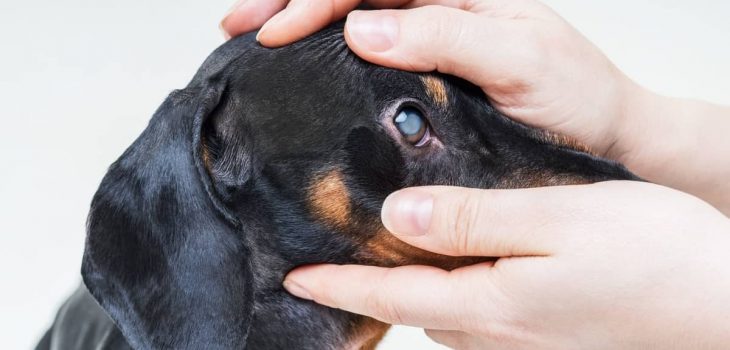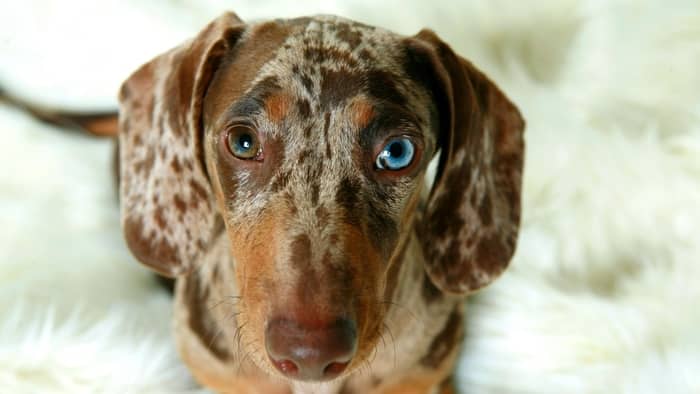Last Updated on September 8, 2021 by Marco
You probably know that puppy eyes change color with time. But exactly when do dogs’ eyes change color and what causes this amazing transformation? If you’ve seen and raised enough puppies in your life, you know that this is as common as it’s fascinating to watch. In fact, the same thing happens with cats, other pets, and even human babies.
The one annoying thing about it, however, is that you can’t always be sure what color the dog’s eyes are going to become later on. And this can be tricky when adopting or buying a young pup.
So, when do dogs eyes change color and why? Let’s discuss.
When Do Dogs’ Eyes Change Color?
Typically, all puppies start with bright blue eyes. However, as adorable as those are, most of them change over time, usually into black or brown. The dog’s eye color change starts around the fourth week of your puppy’s life but it takes longer than that to finish. Often, a dog’s eyes will reach their final color somewhere between the 9th and 16th weeks – that’s almost at 4 months of age.
Why Do Puppies Eyes Change Color?
Now that we know when do puppies eyes change color, the next question is why. The reason is actually the same as with cats, people, and other mammals – it’s that the pigment melanin in the dog’s eyes takes time to develop fully. As long as the melanin keeps developing, the dog’s eyes will keep changing color, typically from lighter to darker.
Why Are Puppies Always Born With Blue Eyes?
As for why puppies always start with blue eyes – technically they don’t. Puppies actually start with clear eyes because there’s barely any melanin in them right after birth. The reason they look blue to us is that we see the reflections and refractions of light inside the pup’s eye and those appear blueish. The adult dog’s eyes will remain blue very rarely as the actual blue eye color isn’t very common.
After that, the more melanin starts to saturate, the more noticeable its color becomes.
How Can You Know What Your Dog’s Final Eye Color Is Going To Be?
Very often you can’t. However, there are some clues you can use to guess with relatively good certainty. These include the dog’s breed, its parents, as well as its coat type. We’ll cover all of those in more detail below.
What Is The Most Common Dog Eye Color?
For most breeds, brown and black are the most common colors. This can feel like a disappointment at first after you’ve watched your pup’s magical blue eyes for a few months. However, the fact of the matter is that most dogs look awesome with brown and black eyes.
The Connection Between Breed and Eye Color Your Pup’s Eyes Are Going To Change Into
If you want a blue-eyed dog, there are a few breeds that have a drastically higher chance to be blue-eyed as adults. Some are in this list because of genetics, others – due to their coat types which we’ll explain in more detail in a bit. Here are the 10 dog breeds that most often have blue eyes:
- Dachshunds
- Siberian Huskies
- Alaskan Klee Kai
- Great Dane
- Weimaraner
- Border Collie
- Australian Shepherds
- Pit Bull
- Catahoula Leopard Dog
- Cardigan Welsh Corgi
How Much Can The Pup’s Parents’ Eyes Tell You?
If both parents of your pup have blue eyes, chances are that so will your pup as it will inherit them. However, if one or both of the parents don’t have blue eyes, the chances of a blue-eyed offspring become insignificantly small. So, if you can take a look at the parents or at least inquire about them, this can give you some useful information.
What Is The Connection Between Coat Color and Eye Color?
The rule of thumb here is that dogs with liver-color coats often have an amber eye color, i.e. anything between light brown and yellowish or grey.
On the other hand, more merle-colored coats have an increased chance of blueish eyes. So, if your dog has a lot of white patches or is fully white, it will have a great chance for blue eyes. That’s because the white fur patches are caused by the same thing that causes blue eyes – a less developed pigmentation.
Unfortunately, dogs with merle coat genes should not be bred because that also leads to an increased risk of blindness and/or deafness.
Do keep in mind that the coat color isn’t everything, however. For example, Huskies often have blue eyes not because of their coats but because of a completely unrelated genetic mutation.
Why Do Some Dogs Have Two Different-Colored Eyes?
Another fascinating question is that of the dogs with different-colored eyes. This phenomenon is called Heterochromia. What causes this condition is pretty familiar – a lack of pigment but this time only in one of the two eyes. So, one eye gets the color it’s supposed to have while the other remains blueish because it doesn’t get pigment.
The condition is both harmless and hereditary. So, if your pup’s parent has it, you can expect your pup to have it as well. Then again, the condition can also happen due to eye injury later in life. Either way, it’s usually good to consult with a vet, just to be safe.
Different Types Of Heterochromia In Dogs:
- Complete Heterochromia (Heterochromia Iridis) – this is the traditional case in which one eye is completely devoid of pigment.
- Partial or Sectoral Heterochromia – the iris of one eye will be only partially blue.
- Central Heterochromia – the actual color of the eye is mixed with another color in a spiked pattern coming out of the pupil.
So, When Do Dogs’ Eyes Change Color, and Should You Want Until Then To Adopt/Buy Your Puppy?
If you want to be sure that your dog will have the eye color you see, wait until the 3rd or 4th month before you adopt or buy the puppy. By that time the final color will either be fully solidified or it will be apparent what that color is going to be. It is a gradual process after all.
Or, alternatively – just get whatever pup looks the cutest and raise it without a care for its eye colors. The sooner you get the puppy, the more time for bonding you are going to have. Plus, black and brown eyes also look awesome on any dog breed.
Read more about: Introducing; The Husky and Wiener Dog Mix and All Its Magic
Jordan is an animal–lover who specializes in dachshunds. He has owned and cared for dachshunds since he was a child, and his passion for these unique dogs has only grown with time. Jordan is an avid researcher and learner, and spends a large portion of his free time studying the history, behaviour, and health of dachshunds. He has a knack for training and socializing his own dogs, and loves introducing them to new experiences. When not caring for his own pets, Jordan likes to volunteer at local animal rescue shelters, helping to find homes for abandoned dachshunds. He is a true animal advocate, and dedicates his time to ensure that all animals receive the love, respect, and care they deserve.





